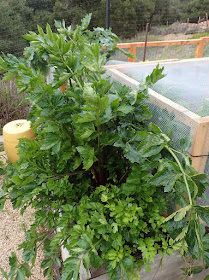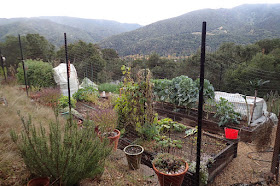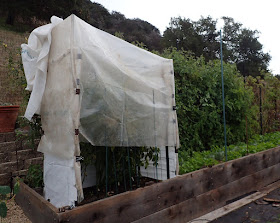Bed #1 was where the curcurbits grew through the summer and into the fall. Everything is dead and done except for the Tromba D'Albenga squash. The vines are slowly succumbing to powdery mildew but they are still putting out a few squash now and then (more to show off next Monday!).The plants seem to appreciate having the entire bed all to themselves in which to spread their vines.
Bed #2 was home to the tomatoes and peppers this year. I've just started to take the tomato plants down, the ones at the near end of the bed in the above photo were pretty ratty looking but they were actually trying to put out new growth. And you can see that the rest of the vines are still alive and well, some actually look healthier than they did back in the summer. There's still a bunch of green tomatoes growing also. It's rather difficult to pull them out when they look so good. I will have to remove all the plants fairly soon, dead or alive, so that I can sow some fava beans along the trellis. The Robin Hood favas are growing well and so is the Kodiak mustard that is flanking them. I may have to give the mustard a haircut pretty soon so it doesn't overshadow the favas.
The Aji Amarillo Grande pepper plants still have a lot of green and ripening peppers on the plants so I've rigged up a cover for them to both keep them a little warmer during the day and protected from frost at night. There's both Agribon frost cloth and greenhouse plastic surrounding them. During the day the plastic is trapping a bit of warmth and if frost threatens I can pull the frost cloth over the top and down the front to provide some extra protection. The Baby Aji Amarillo plants have finished producing, nearly every pepper ripened on the plants, but the plants are alive and healthy so I'm hoping to get them through the winter so I can move them in the spring and perhaps get a head start on them next year. Baccatum peppers are more cold hardy and perennial than annuum peppers so unless we have an unusually hard freeze there's a good chance they'll survive our typically mild winter.
Bed #3 is in transition now. I cut down all the corn stalks, and cut down the dead snap bean vines and moved the trellis to where the Puhwem corn had been growing. I would like to try to grow some winter snow peas tucked in amongst the stumps of the corn plants, but I'm not sure I'll get around to it. The pea vines are still soldiering on under the fabric further down the bed. I've been getting a few handfuls of snow peas about once a week, but most of the shelling pea plants died.
I set out seedlings of Batavia broccoli where the snap beans had been growing. My experiments with starting broccoli under water bottle cloches worked so well last winter that I'm continuing the experiment this winter. The seeds were sown together in 4-inch pots and then I separated the seedlings and set them out in the garden under the cloches. I used to pot them up into individual quart sized pots before putting them into the garden, but my new method saves the hassle of tending to the potted plants. The only time I'll do the potting up from now on is if there isn't room in the garden for the seedlings when they need to be potted up or planted out. And look at those I'itoi onions - they're so happy!
 |
| Batavia Broccoli Seedling |
Spinach is getting the same cloche treatment.
The frost last week didn't faze the nasturtiums so I'm letting them grow on. The Anna's hummingbirds which are year round residents here appreciate the flowers.
This patch of Kodiak mustard has a few more weeks to grow before I have to dig it in to prepare this spot for onion seedlings.
Bed #4 is where most of the harvest action is going on but I've added a few new veggies as well.
That was a couple of heads of Manoa Crisphead lettuce which didn't look so bad after some trimming.
The lettuce got replaced with Kongo and Kolibri kohlrabi seedlings and Palla Rosso radicchio seedlings. (The photo looks weird because I accidentally set my camera on some artsy fartsy setting.)
 |
| Kohlrabi Seedling |
 |
| Dazzling Blue Kale |
 |
| Gustus Brussels Sprouts |
Future Brussels sprouts harvests in the Enchanted Brussels Sprouts Forest. (My apologies to Mollie Katzen...)
I had to whack back the Peppermint Stick chard because the ants decided to cultivate an aphid colony in its leaves. I guess they don't like the Syrian chard as much and the Golden chard which has been colonized before has escaped the attention so far.
 |
| Pink Plume Celery |
The aphids also discovered the Tronchuda Beira cabbage and Russian Hunger Gap kale so I trimmed all of them quite drastically, but they seem to be recovering.
The carrots and parsnips are loving the cool wet weather.
One more look at those Brussels sprouts. I didn't think they would amount to much this year but they've come around. A couple of the Hestia plants are still producing big loose sprouts but I've found that those are perfectly fine for shredding so I've not taken the plants out as I threatened to do.
That's the latest in my garden. Thanks for taking the tour!





















Timely post.
ReplyDeleteI was just gonna ask you some questions. I bought some vegetables at the supermarket and they were uniformly AWFUL. I can see why people don't like them. So for me right now the reason to grow my own is that they taste so much better. (My dad had a victory garden during WWII and I was raised on fresh ones.) Then I was reading Louis Diat's French Cooking for Americans again. In it he makes a distinction between seasonal and storage vegetables. Aha, I thought. This what's wrong with bundles I've been getting from the farmer's market. All storage vegetables. So yesterday I went out and re-planted many seasonal vegetables: spinach, turnip, radish, broccoli raab, purple sprouting broccoli and bunching onion. I also started that same squash you mentioned because the package said after frost, well, with no frost it is always after frost.
My questions for you are:
1. Winter tomatoes. What varieties? Internet pages say small ones like yellow pear. What works for you?
2. Winter squash. I cut into my humungous Cinderella pumpkin. How do you preserve/save it after it has been cut?
3. What else would you plant for winter seasonal vegetables?
I have chard ready and cucumbers and snow peas growing well. Cabbages were devoured by those green worms long time ago.
I'm glad you're there to ask these questions to! You have loads of experiments and experience.
Whew, let me tackle the easy question first. Humongous winter squash. I don't grow them anymore because of that very problem. It will keep for a few days in the fridge if you cover the cut sides, but just how much squash can you eat in a week? I usually ended up roasting and pureeing it and then freezing the puree in portions that I could thaw to use in various things like soup or ravioli filling or just served as squash puree with butter and sage, or some such dish.
DeleteWinter tomatoes. Well, I really don't grow winter tomatoes, the ones I have now are just holdouts from summer. The winter tomatoes that I've experimented with are ones that are meant to store well through the winter. They are generally small fruited and tough skinned, usually harvested green and kept on the vines, the vines hung somewhere protected and the tomatoes are supposed to eventually ripen. My experiments never turned out well. Better to have a fresh tomato in season. But I will say that the tomatoes that are on my plants now set in the unusually warm weather that we enjoyed back in October and November. Even though we've not had a killing freeze yet here, there aren't any new tomatoes setting because the nights are too cold, tomatoes don't pollinate if temperatures dip below 50ºF in a 24 hour period. And I will comment that the Piccolo Dattero cherry tomatoes that I grew for the first time this year, what's left on the plants are still absolutely delicious when they finally ripen. And of all the large fruited tomatoes that I grew another Italian one, Pantano, has the most green tomatoes on the plants. I've been picking those when they start to show a little color and then I let them ripen on the kitchen counter. Their flavor has been surprisingly good. So that's probably not the advice you were looking for regarding winter tomatoes, but that's what I can offer.
So, winter seasonal vegetables... You should be able to grow most any salad green, like lettuces, arugula, cress, mache, mustard/mizuna. And now might be the time to try the cabbage again since the cabbage moths aren't active so they won't be laying eggs. Kale might do ok, though it might bolt fairly quickly in the spring. Carrots might be ok, beets if it's not too cold (they won't germinate but they will grow if you can get them going).
You've got cucumbers growing? Not possible here, just too cold, if they manage to grow they become stunted and never produce much.
Generally, for my climate, winter veggies are mostly greens and roots and shoots. Things that have to bloom and set fruits don't do anything. Some things like peas will grow and then when the weather warms up they go into a frenzy of production, but if it's too cold they don't do much. Speaking of peas, if you like pea shoots, that's a go.
So, I encourage you to just go for it! Plant things and see what happens. That's what I do. Sometimes it works and sometimes it doesn't. I have always learned more from my failures than successes.
Thank you! I think I'll go after some giant red mustard and other Asian greens starts (because they are available here) although they tend to sulk until late January when everything bursts at once!
DeleteYou still have a tremendous amount going strong. We also grew Robin Hood beans but they are long gone.
ReplyDelete